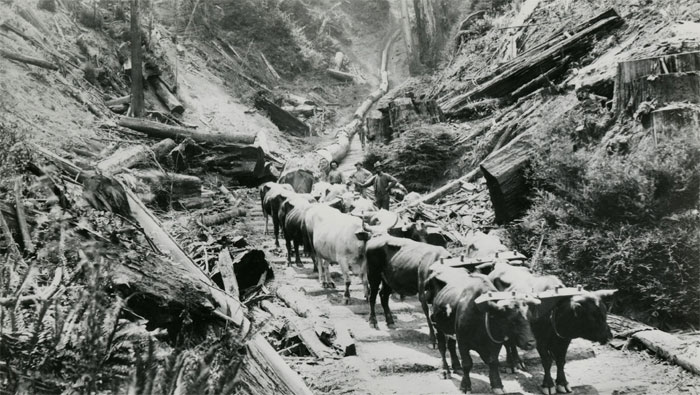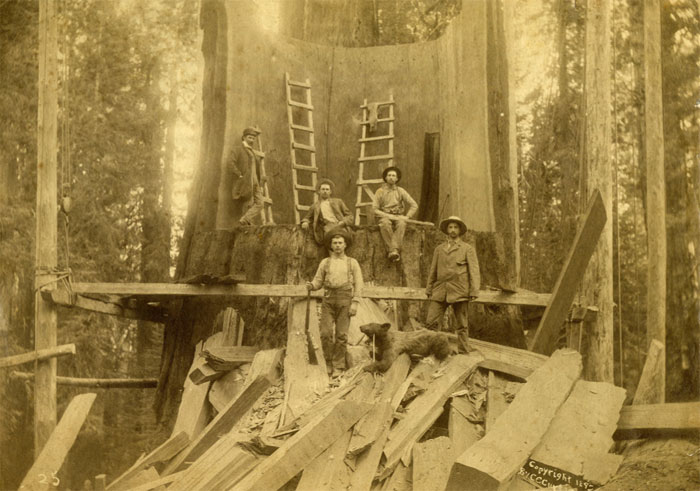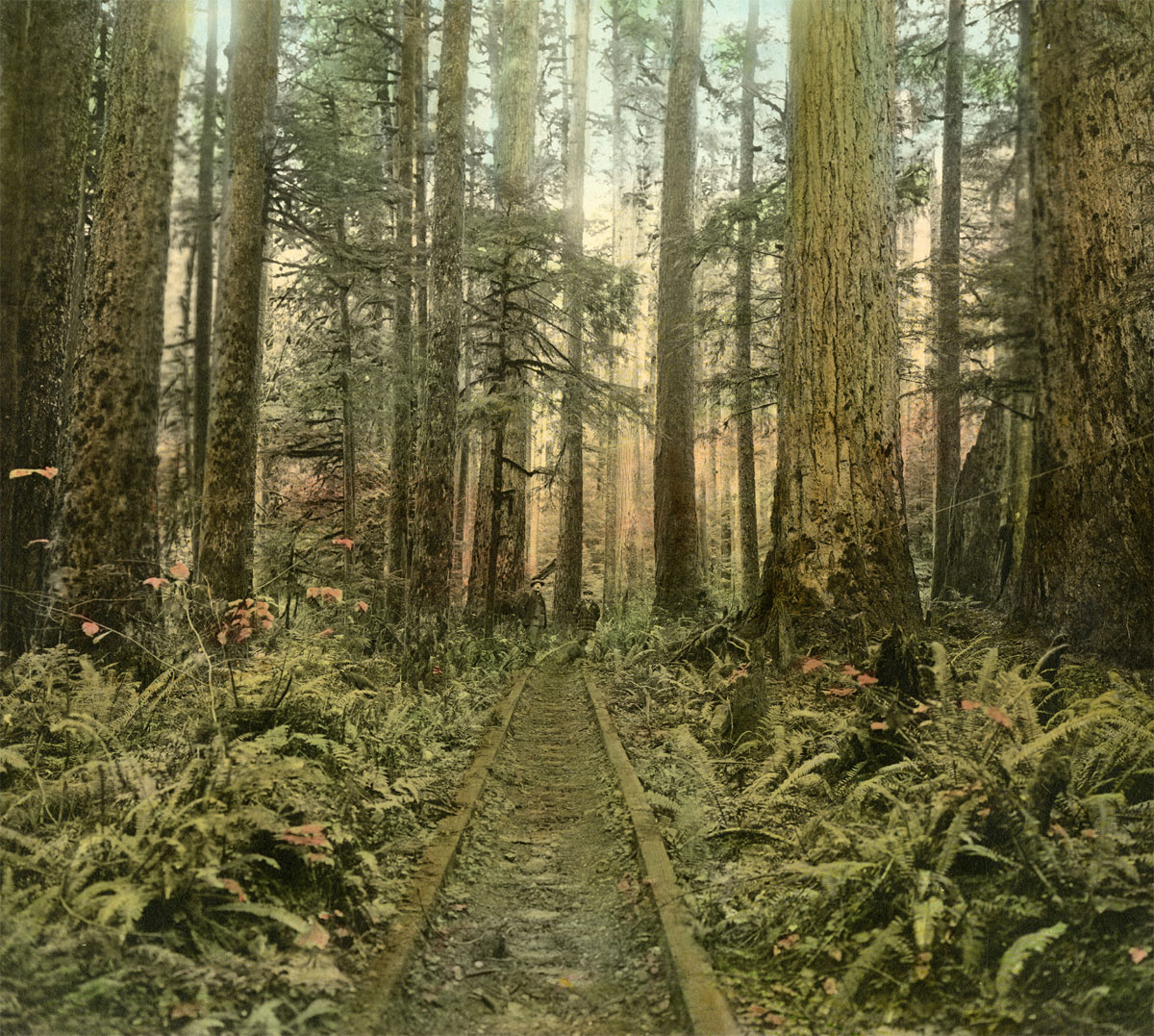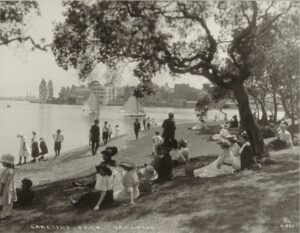Lost Worlds of the San Francisco Bay Area, published by Heyday, is a coffee table book of vignettes by author Sylvia Linsteadt. Each essay is researched but also an act of historical imagination. This is an excerpt about the extractive history of redwood logging in the Oakland hills. Click here to read another excerpt about coal mining at Mount Diablo. Today both areas are parks, protected and restored by the East Bay Regional Park District and open to the public.
There is a quality of silence under redwood trees that cannot be named. It is not just the floor of thick, orange-needled duff and how it absorbs all footfalls into its own quiet, nor is it simply the way the light changes, softening and darkening to a cadence more candle than sun. It is not size alone either, though the great old giants in the Oakland hills originally reached more than thirty feet in diameter, thriving on slightly more inland sun and warmth than their coastal kin. To be in the presence of living things so enormous is its own conversation with the deep time of this earth, and therefore an intense encounter with all that is mysterious and vast. The quality of quiet peace that descends when you enter a redwood grove comes from the sum of all these together, the way trees create their own world of sound and light and time. Because of the way they grow—close and thick—and gather fog in their branches and drip it down to their roots, the climate in a redwood forest is cooler than all surrounding areas; they, in a sense, engineer their own weather. And because of the acidity of the soil they create with their leaf humus, and the strength of their shallow but thick roots, only a select community of other plants can grow in redwood shade. To venture into that spiced and ancient grove is truly to step into an older rhythm of time, one made by the trees themselves.
Such silence lasted for millennia. In the hills east of Oakland, a pocket of ancient and enormous redwoods thrived just where the ocean fog reached and rested, in a small band spanning the ridge from present-day Redwood and Leona parks east to Moraga—roughly five square miles of dense, old-growth forest. Because redwoods crown sprout from stumps and the roots of fallen ancestors, the age of such a forest is almost inconceivable—while a 32-foot broad, 300-foot tall tree might represent a millennium of vertical growth, the genetics and rootstock below might span many thousands, if not millions, of years. But it took little more than fifteen years, from 1845 to 1860, for crews of loggers to level the entire forest. Even many of the stumps were dug out and cut into cords of firewood or shingles, preventing the next generation from crown sprouting around its old grandfather. Only one original tree remains today, a twisted runt of an old-growth redwood, ninety-three feet tall, growing miraculously out of a rock on a cliff face near Merritt College and probably too difficult to reach, or to catch as it fell, for loggers to bother.

Long before they were logged, the redwoods along the ridge were well known by sailors. Two giants, called the Navigation Trees, stood at the edge of a grove, silhouetted stark against the horizon, and were first recorded by British navy captain Frederick William Beechey in 1826. He discovered that in order to avoid colliding with Blossom Rock, an underwater island visible only at low tide, and safely land in the San Francisco harbor he must line up the tip of Yerba Buena Island with “two trees on the top of the hills too conspicuous to be ignored.” When the Navigation Trees were logged after 1855, the army blew up Blossom Rock in order to avoid shipwrecks.
Oakland’s enormous redwoods were not easy trees to fell, due not only to their size but also to their location up steep and roadless canyons. A handful were cut here and there before 1850, mainly by two French carpenters in the early 1840s who hand-milled the wood and transported it down from the hills on small boats that navigated the streams, then across the Bay to the small settlement of Yerba Buena (later San Francisco). But mostly the woods were quiet, especially after 1842, when John Sutter began milling wood in the Sierra and at Fort Ross, which he’d just purchased from the Russians, dominating the lumber business in the area for several years.
But then the year 1849 tolled its heavy golden bell and, flooded by gold-hunters from all over the world, the little town of Yerba Buena swelled beyond anyone’s reckoning. San Francisco—as the little town was rechristened—was “lusty and inflammable” in the words of twentieth-century chronicler Sherwood Burgess, and it had a voracious appetite for wood. Finding gold panning less lucrative on the whole than they’d thought, weary forty-niners were soon rushing up to the hills and joining makeshift logging camps, where the arrival of the first steam sawmill on Palo Seco Creek jump-started a new era of redwood lumbering in the East Bay. More and more towns pushed up out of nowhere like mushrooms, demanding wood—Martinez, Benicia, Lafayette. The lumber port at San Antonio, which was shipping many tons of redwood lumber up and down the Bay each day by the early 1850s, soon became the Port of Oakland, and the city of Oakland grew quickly around it. Virtually all east-west roads through Oakland were planned in relation to the logging camps in the hills and were used by mule and ox teams to drag wood down out of the forest to the port. The old-growth redwoods became the new towns of the East Bay and much of the city of San Francisco (including its famous cable cars) all in what, to the trees themselves, must have felt like no more than a single inhalation of time.
Roads and steam mills make the whole undertaking sound orderly and staid, but in truth the logging of the East Bay redwoods had all the characteristics of the gold rush about it and was undertaken by many of the same men. These were men “with a talent for exploitation unseen in this country before.” Really, it was a savage and devastating free-for-all, each mill operator and his men racing all competitors for access to virgin stands of trees. In no time there were ten sawmills, nine of them steam powered, one powered by water.

According to the diaries of Joseph Lamson, owner of a lodging house and a liquor and grocery store deep in the redwoods from 1853 to 1855, the mill workers were a rowdy, rough-dealing, hard-drinking lot, often called the “redwood boys” or the “redwood rangers,” like some band of terrible and legendary outlaws. They would materialize suddenly out of the thick forest to exact their own form of justice, particularly over the loss of property. In one instance, two hundred and fifty of them emerged from the woods and surrounded the Oakland home of a man they suspected of stealing three oxen from the sawmill operator Hiram Thorn (after whom Thornhill Road in Oakland is named). They threatened him with lynching, and marched up and down the surrounding streets, rifles at the ready, shouting that they would “lay the town in ashes” if the man didn’t fork over payment for the lost oxen by the following day. Indeed, their menace was such that it took the intervention of the mayor, Horace Carpentier, and his offer of money out of the city’s own coffers, to set the matter straight. Lamson’s diary descriptions of a rattlesnake barbeque and the infamous Hannah—a “Kanaka Lady” who rode bareback through the redwoods in her straw hat and calico dress amusing the men—begin to sound slightly fantastical, cloaked in the extravagance of bandit legends. And yet his notes are the only remaining firsthand record of this strange and violent time, impressions scrawled at the far edges of settled society, and must be taken as such. There, cloaked in the old darkness of redwoods, the logging camps seemed to become a kind of no-man’s-land, where only the toughest customers ventured.
By 1854, the biggest trees were gone, and by 1860, all the mills had closed down. The hills were a ragged quilt of stumps. The delicate root systems of the shy understory plants, such as redwood sorrel and trillium, were so damaged by the ravages of oxen teams and the deep furrows made by the trees they dragged behind that even today, few sorrel or wake-robin communities have returned. All the redwoods now protected within Redwood Regional, Sibley, Anthony Chabot, Leona Canyon, and Joaquin Miller Parks are a spry young third-growth generation, tiny in comparison to their ancestors, and lonesome too. No longer do giant California condors nest in their boughs, nor do grizzly bears come padding down through the orange-spiced duff in the dead of night to steal oxen from the pens of loggers. And the silence of redwood forest, though still palpable if you venture up a side canyon, far from any trail, has lost something of its pulse. These young trees, only a century old at most, now stand within the confines of human time. It will take thousands of years for them to become ancient giants again, with the span of stars in their embered bark.





